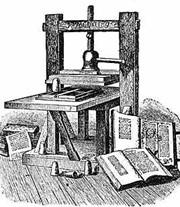by ProfDave, ©2022
(Apr. 28, 2022) — The 300 – 350-year period from the 14th to the 17th centuries is the boundary between medieval and modern in Europe called “Renaissance and Reformation.” It encompasses not only the geographic expansion of European influence, but also an exponential expansion of knowledge, of government, and of religion.
Although, by our standards, the Renaissance was a very narrow movement, limited to artists, scholars and those who sponsored them, it prepared the way for modern thinking. Note: revisionist historians push modern thinking back into the Middle Ages. It began in Italy, perhaps because of the presence of so many monuments to the ancient world, or contact with the East (Arab and Greek, merchants and refugees), or prosperous courts competing for cultural splendor, or the relative freedom offered by the multiple independent polities, or all of the above? And it spread to the north. The Middle Ages had created an international Latin community of scholars, almost exclusively churchmen, who used the ancients exclusively as authorities and information sources. The pinnacle was reached in Thomas Aquinas’ (1225-74) synthesis of the teachings of the church with the philosophy of Aristotle. But William of Occam (1287-1347) questioned whether God (revelation) could really be limited by human reason and conversely, whether revelation could be applied to all fields of study. Perhaps science and theology could operate independently, using different methods?
In the Renaissance, roughly from Petrarch (1304-74) to Erasmus (1466-1536), we have a scholarly and artistic movement that 1) took a more comprehensive interest in the ancients than ever before or since, 2) expressed a very optimistic view of human potential, and 3) expressed themselves on serious subjects for laymen and in vernacular languages as well as Latin.
First, the Greeks, Romans, and Hebrews were not merely sources of information, but examples for thought, aesthetics, and practical action. For example, Cicero (106-43 BCE) became a model for Latin style. Heroic historical examples were applied to the education of Princes by Machiavelli and others. And the idea was to think and act like the ancients, not just copy their conclusions.
Secondly, while most Renaissance figures were either clergymen or very religious laymen, they are collectively referred to as Humanists. They held that certain individuals were capable of great genius and virtue. These were gifts from God, but to be applied in this life, not the next. They were rather elitist despite their humble origins. Some earned, by their talents, almost rock-star popularity. Again, they focused primarily on this life, rather than the next.
Thirdly, their interests encompassed both sacred and secular subjects, pagan and Christian sources, and modern as well as classical languages. Nothing was off limits. Even their spirituality bypassed theological filters and the sacraments. They attacked hypocrisy and worldliness in the church. They published scholarly editions of the Fathers and of the Scriptures (as well as Plato and Aristotle) in the original languages and committed serious writings to local languages for the first time.

But the real explosion of knowledge came about 1450, when Johannes Gutenberg adapted a wine press to print books, using moveable metal letters. Hundreds of copies could be made in a few days or weeks instead of a monk taking a year to produce one book! A whole new industry was created overnight. The works of Renaissance humanists, Bibles and novels, scholarly editions and popular pamphlets, tracts and posters flooded Europe in profusion at a fraction of the previous cost. Connoisseurs might still prefer handwritten copies, but now reading material became cheap enough for ordinary people. It was worthwhile to learn to read! The impact of the internet in our time is minor compared to this information revolution!
The explosion of government was more gradual – and continues to this day! We have seen how the power of kings had begun to grow in late medieval times. Lawyers and bureaucrats were added to the churchmen (“clerks”) used by earlier princes. Administration became more professional and extensive. Armies grew larger. Governments became more expensive and financing them became big business. Courts competed for glory. The escalation both of organization and of financial need were significant factors in the expansion of Europe – and contributed to the religious crisis of the 16th century, too. Without government resources (and credit) Columbus would have never sailed.

Nor would the Reformation of the 16th century have happened in the form it took had not the papacy been caught up in the explosion of government and the printing press had not spread discontent and spiritual ferment. At the risk of oversimplification, there seems to have been a great upswing in popular piety and religious intensity in the latter part of the 15th century. Some of this was in reaction to the discord and disruption of the previous century, some stirred up by the new ideals of Renaissance humanism, some encouraged by the new availability of printed sermons, saints’ lives, Bibles, and devotional literature. Unfortunately, the Roman hierarchy was too distracted with administrative and temporal concerns (protecting its prerogatives as a major power) to maintain leadership of this movement. As a result, while the church extended itself worldwide in crusading missionary zeal, the unity of Christendom in Western Europe was forever shattered. By 1648 the Papacy was no longer a major temporal power but had regained much of its spiritual initiative in a much wider world. Next week we will explore that wider world.
David W. Heughins (“ProfDave”) is Adjunct Professor of History at Nazarene Bible College. He holds a BA from Eastern Nazarene College and a PhD in history from the University of Minnesota. He is the author of Holiness in 12 Steps (2020). He is a Vietnam veteran and is retired, living with his daughter and three grandchildren in Connecticut.

